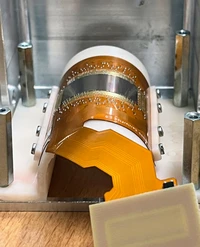Studying the effects of bending on BabyMOSS
The ALICE experiment is planning to replace the innermost three layers of its current tracker with wafer-scale CMOS MAPS sensors bent around the beam pipe. Such a detector concept has never been built in any experiment so far, and the ITS3 project aims to tread new ground on many major R&D aspects of MAPS detectors within its ambitious goals. The BabyMOSS sensor (the smaller variant of the MOSS sensor designed to study stitched sensor performance and reliability) is one of the prototype sensors developed in this context.
The sensor itself has been characterized in detail and has been studied in a wide range of settings; it is yet to be operated in a bent configuration, as the final ITS3 sensors will be. For this, our group has been involved in designing a modified readout system and sensor integration system (in collaboration with Max-Planck Halbleiterlabor (HLL)). We have produced the first samples of BabyMOSS sensors assembled on flexible PCBs (FPC), which have enabled us to study the sensors bent to different radii.
